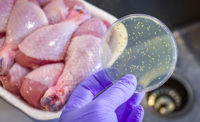Fight for Food Safety
2019: Another banner year for recall data in the meat industry

With 2020 under way, we thought it would be interesting to evaluate last year’s recall data for the meat industry. Certainly, there are many ways to measure the performance of the food industry. Annual recall data can provide interesting snapshots into the industry’s overall food safety performance. Ideally, we hope to see progress made from year to year, which would reflect lessons learned in our pursuit of ever-safer, more wholesome food.
In 2019, there were a total of 124 recalls of product inspected by the U.S. Department of Agriculture (USDA). This equates to approximately one recall every three days. Collectively, the recalls affected a total of approximately 20.6 million pounds of product. The largest recall (11.8 million pounds) involved various chicken products that may have been contaminated with foreign materials (metal). This recall is especially notable for its size, accounting for 58 percent of the total pounds of product recalled in 2019.
The largest pathogen-related recall (135,810 pounds) was for frozen diced chicken potentially contaminated with Listeria monocytogenes. Compare that with 2018, when the largest pathogen recall (17.2 million pounds) involved raw beef believed to be responsible for a Salmonella outbreak that resulted in 246 confirmed illnesses in 25 states.
Interestingly, there was a total of 124 USDA recalls in both 2018 and 2019. The 2019 recalls, however, involved 5 million fewer pounds. One of the most encouraging comparisons relates to the recalls resulting from pathogen concerns. In 2018, there were 36 pathogen-related recalls. That number dropped precipitously, to 17 pathogen-related recalls, in 2019. That is less than half of the 2018 total. Moreover, the decline comes amidst ever-improving surveillance and traceability, which means the year-to-year decline is likely larger than the numbers represent.
There is more good news. From 2018 to 2019, Salmonella-related recalls dropped from 18 to four, a 400 percent decline. Similarly, Listeria monocytogenes-related recalls fell from 20 to seven. Combined, these figures represent extraordinary improvement.
Of the 17 pathogen-related recalls, the products were tied to only three outbreaks. One outbreak, from ground beef, caused more than 200 E. coli O103 illnesses. Another was associated with an outbreak of Salmonella, involving 10 patients. The third involved a two-state outbreak, with five outbreak cases. In that outbreak, the Wisconsin Department of Agriculture collected three intact turkey samples from a residence at which four of the patients were living. While even one illness is too many, the industry improved significantly in 2019.
As we all know, it is our responsibility to make all food as safe as possible, and illnesses are never acceptable. With that said, 2019 was a good year, and the industry is continuing to do an excellent job. If you are among the thousands of incredible people who work tirelessly to keep our food safe, you should be proud of your impressive accomplishments. NP
Looking for a reprint of this article?
From high-res PDFs to custom plaques, order your copy today!









